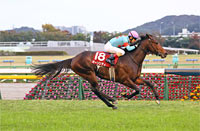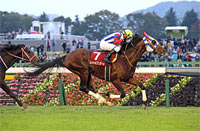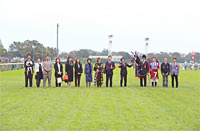Copa Republica Argentina (G2) - Data Analysis
Handicap race notable for strong performance by favored runners
The Copa Republica Argentina is a handicap race that has been consistently won by favored runners in recent years. The last time Trifecta bets for the race paid out more than JPY100,000 was in 2009, and nine of the 10 races held since 2010 were won by runners backed as 3rd favorite or higher. This year again, the big question is whether one of the fancied runners will live up to expectations, or whether a dark horse will take us all by surprise and snatch the spoils for the first time in many years. Let’s now analyze some features shared by successful runners in this race from results over the last 10 years.
Career length and recent race performance are key factors
Looking at performances by runners over the last 10 years by career starts, we find that runners with “15 or fewer” career starts achieved an extremely high Top 3 ratio of 60.7%. In other words, we should raise our expectations of runners entering the race with 15 or fewer career starts. [Table 1]
[Table 1] Performance by career starts (last 10 years)
| Career starts |
Performance
[1st-2nd-3rd-4th or lower] |
Win ratio |
Top 2 ratio |
Top 3 ratio |
| 15 or fewer |
8-2-7-11 |
28.6% |
35.7% |
60.7% |
| 16 or more |
2-8-3-120 |
1.5% |
7.5% |
9.8% |
In addition, among runners with “16 or more” career starts, those with no experience of finishing within the Top 6 of a “JRA open-class race held since May of the same year” were all beaten to 4th or lower. [Table 2]
[Table 2] Among runners with “16 or more” career starts, performance by experience of finishing within Top 6 of “JRA open-class race held since May of the same year” (last 10 years)
| Experience |
Performance
[1st-2nd-3rd-4th or lower] |
Win ratio |
Top 2 ratio |
Top 3 ratio |
| Yes |
2-8-3-61 |
2.7% |
13.5% |
17.6% |
| No |
0-0-0-59 |
0% |
0% |
0% |
Moreover, among runners with “16 or more” career starts, those that had “finished 8th or lower, or were pulled up” in their previous race were all beaten to 4th or lower. When comparing runners with “16 or more” career starts, we should carefully consider their performance in open-class races held since May of the same year and their finish in the previous race. [Table 3]
[Table 3] Among runners with “16 or more” career starts, performance by finish in previous race (last 10 years)
| Finish in previous race |
Performance
[1st-2nd-3rd-4th or lower] |
Win ratio |
Top 2 ratio |
Top 3 ratio |
| 7th or higher |
2-8-3-60 |
2.7% |
13.7% |
17.8% |
| 8th or lower, or pulled up |
0-0-0-60 |
0% |
0% |
0% |
Grade and time difference in previous race are also important
Looking at performances by grade of previous race, we observe that runners that had contested a G1 race last time out achieved an excellent Top 3 ratio of 38.5%. This suggests we can place our trust in runners coming straight from big races. [Table 4]
[Table 4] Performance by grade of previous race (last 10 years)
| Previous race |
Performance
[1st-2nd-3rd-4th or lower] |
Win ratio |
Top 2 ratio |
Top 3 ratio |
| G1 race |
3-1-1-8 |
23.1% |
30.8% |
38.5% |
| Non-G1 race |
7-9-9-123 |
4.7% |
10.8% |
16.9% |
Meanwhile, among runners that had contested a non-G1 race last time out, those that had finished 2nd or lower in their previous race with a time difference of 0.8s or higher with the winner of that race struggled with a Top 3 ratio of 3.2%. When comparing runners that have contested a non-G1 race last time out, we should check their finish in the previous race and time difference with the winner in that race. [Table 5]
[Table 5] Among runners that had contested a non-G1 race last time out, performance by finish in previous race and time difference with winner in that race (last 10 years)
| Finish in previous race and time difference with winner in that race |
Performance
[1st-2nd-3rd-4th or lower] |
Win ratio |
Top 2 ratio |
Top 3 ratio |
| 1st, or 2nd or lower with time difference with winner of 0.7s or less |
7-8-8-62 |
8.2% |
17.6% |
27.1% |
| 2nd or lower with time difference with winner of 0.8s or more |
0-1-1-60 |
0% |
1.6% |
3.2% |
Note: Excluding runners who were pulled up in previous race.
Watch “final sprint” last time out
Of the 30 Top 3 finishers over the last 10 years, 23 were ranked “4th or higher” in their estimated time over the final three furlongs in their previous race. These runners achieved an excellent Top 3 ratio of 37.7%. When comparing recent performances of runners, we should check their “final sprint” in the previous race. [Table 6]
[Table 6] Performance by ranking in terms of estimated time over final three furlongs last time out (last 10 years)
| Ranking by estimated time over final three furlongs last time out |
Performance
[1st-2nd-3rd-4th or lower] |
Win ratio |
Top 2 ratio |
Top 3 ratio |
| 4th or higher |
8-7-8-38 |
13.1% |
24.6% |
37.7% |
| 5th or lower |
2-3-2-92 |
2.0% |
5.1% |
7.1% |
Note: Excluding runners who were pulled up in previous race.
Runners starting in inner brackets have the edge in races with a field of 16 or fewer runners
Looking at performances by horse number in races with a field of 16 or fewer runners (2012, 2016 to 2019), we note that horses with numbers “1-7” achieved an excellent Top 3 ratio of 37.1%. In races with a field of 17 or more runners, this trend was not observed. If this year’s race is contested by a relatively low number of runners, we should raise our expectations of runners starting in the inner brackets. [Table 7]
[Table 7] Performance by horse number in races with a field of 16 or fewer runners (2012, 2016 to 2019)
| Horse number |
Performance
[1st-2nd-3rd-4th or lower] |
Win ratio |
Top 2 ratio |
Top 3 ratio |
| 1-7 |
4-5-4-22 |
11.4% |
25.7% |
37.1% |
| 8-16 |
1-0-1-34 |
2.8% |
2.8% |
5.6% |
Seek out the winner!
Age and favoritism in previous race are decisive factors
The last 10 winners of the Copa Republica Argentina were all aged 6 or below. The last horse aged 7 or above to win the race was Inano Lover John (8 years old) in 1985. This suggests horses aged 7 or above are unlikely to emerge as winners. In addition, the last 10 winners had all been backed as 5th favorite or higher in their previous race. The last runner backed as 6th favorite or lower in his previous race to win the Copa Republica Argentina was Yusei Top Run in 1998. In other words, we should lower our expectations of runners that were poorly favored in their previous race. [Table 8]
[Table 8] Winners’ age and favoritism in previous race (last 10 years)
| Year |
Winner |
Age |
Favoritism in previous race |
| 2010 |
Tosen Jordan |
4 |
2nd |
| 2011 |
Trailblazer |
4 |
1st |
| 2012 |
Lelouch |
4 |
1st |
| 2013 |
Asuka Kurichan |
6 |
2nd |
| 2014 |
Fame Game |
4 |
4th |
| 2015 |
Gold Actor |
4 |
1st |
| 2016 |
Cheval Grand |
4 |
5th |
| 2017 |
Suave Richard |
3 |
3rd |
| 2018 |
Perform a Promise |
6 |
4th |
| 2019 |
Muito Obrigado |
5 |
2nd |
(Masaya Ibuki)
|

















